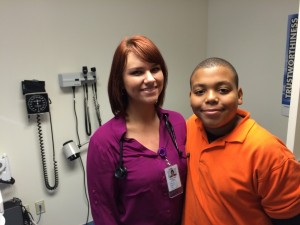Too Many Children & Youth Have Uncontrolled Asthma
Asthma is a common chronic condition among children and youth in California. Although asthma can be effectively managed, many children and youth lack access to regular medical services and end up making unnecessary visits to the emergency room. These ER visits are difficult for families and costly for our health care system.
- 16% of California children aged 5-18 have, at some point in their lives, been diagnosed with asthma.1
- 48% of children age 18 and younger who had asthma reported having one or more asthma attacks in the past year.2
- Among California children aged 5-18 who currently have asthma, 9% had an asthma-related emergency room or urgent care visit in the past year. Among children living in poverty, this percentage rises to 16%.3
Children of color are disproportionately burdened by asthma. Whereas the prevalence of asthma among white children is estimated at 7.6 percent, these estimates increase to 13.4 percent for African American children and 8.5 percent for Hispanic children.4
- Blacks have 40% higher asthma prevalence than Whites, four times higher asthma ED visit and hospitalization rates, and two times higher asthma death rates. Asthma hospitalization and ED visit rates are higher in Latinos (all subgroups combined) when compared to whites, especially among children.5
- In California, the odds of having asthma are 1.7 times higher for African Americans than they are for white children.6
In addition, asthma is a common cause of school absence: children with asthma miss 13 million days of school annually.7 This impacts individual students’ academic achievement and it impacts overall school funding: students with asthma miss three times more school.8
School-Based Health Centers Help Manage Asthma
School-based health centers (SBHCs) help children, youth, and families manage asthma, keeping kids out of the hospital and in school and saving money for our health care system. More specifically, recent research shows that:
- SBHC users are less likely to have asthma-related restricted activity days.9
- SBHC users miss less school as a result of their asthma.10
- SBHC users are less likely to go to the ER or be hospitalized for asthma.11, 12
- When children with asthma have access to an SBHC, less is spent on ER visits and hospitalizations.13
Citations
(1) California Health Information Survey (CHIS), 2009.
(2) Centers for Disease Control and Prevention. (2018). “Asthma: Most recent asthma data”.
(3) California Health Information Survey (CHIS), 2009.
(4) Asthma and Allergy Foundation of America. (2019). “Asthma facts and figures”.
(5) Let’s Get Healthy California. (2016). “Healthy beginnings: Reducing childhood asthma ED visits”.
(6) Meng, Y., Babey, S.H., Hastert, T.A., & Brown, R.E. (2007). California racial and ethnic minorities more adversely affected by asthma. University of California, Los Angeles. Center for Health Policy Research.
(7) Akinbami, Lara J., Centers for Disease Control and Prevention. (2006). The State of Childhood Asthma, United States, 1980-2005. Advance Data. 381:1-24.
(8) Cicutto, Lisa, et al. “Creating asthma‐friendly schools: A public health approach.” Journal of school health 76.6 (2006): 255-258.
(9) Mansour, Mona E., et al. “Pursuing perfection: An asthma quality improvement initiative in school-based health centers with community partners.” Public health reports 123.6 (2008): 717.
(10) Webber, Mayris P., et al. “Burden of asthma in inner-city elementary schoolchildren: do school-based health centers make a difference?.” Archives of pediatrics & adolescent medicine 157.2 (2003): 125-129.
(11) Mansour et al.
(12) Guo, J. J., et al. “Impact of school-based health centers on children with asthma.” Journal of Adolescent Health 37.4 (2005): 266-274.
(13) Guo et al.





 West Oakland is a small neighborhood in Alameda County, California, on the shores of the San Francisco Bay, where residents live near thousands of moving and stationary sources of diesel pollution. Container trucks carry goods to and from the Port of Oakland, U.S. Postal Service trucks carry mail to a major distribution center, and trucks and automobiles move overhead on freeways that surround the community.1
West Oakland is a small neighborhood in Alameda County, California, on the shores of the San Francisco Bay, where residents live near thousands of moving and stationary sources of diesel pollution. Container trucks carry goods to and from the Port of Oakland, U.S. Postal Service trucks carry mail to a major distribution center, and trucks and automobiles move overhead on freeways that surround the community.1